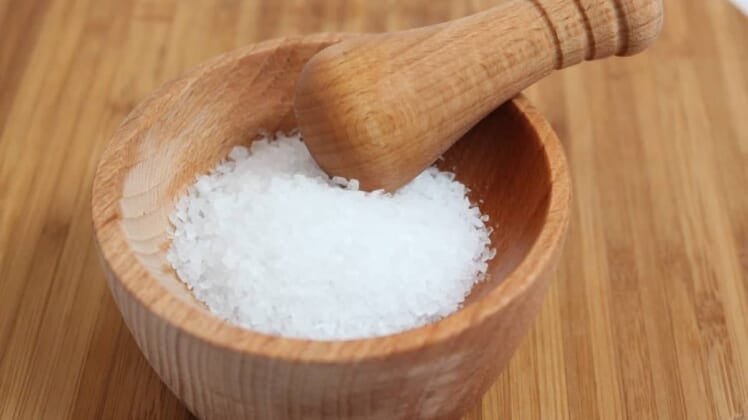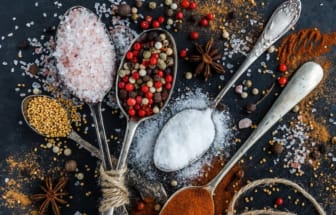Sea Salt vs. Table Salt: What’s the Difference?

Whether mined from deeply buried underground seabeds or harvested directly from the sea, the debate over which salt is better for you – sea salt vs table salt – can be controversial.
Some of us defend good old table salt as being the one and only “true” salt to use while others are into specialty salts such as sea salt to flavor their foods.
SALT FACT: There is almost an inexhaustible supply of salt from the sea, providing an average of 26 million tonnes per cubic kilometer, which if extracted would cover the world’s total landmass to a depth of almost 115 feet.
So, no matter which salt side you stand on, one thing is for sure, salt is all around us.
What’s the Debate?
The debate over which is better, table salt or sea salt, was partly started when many food companies and food shows started adding sea salt in lieu of table salt. Observant consumers have picked up on that change and have also started adding sea salt for everyday use.
To get a better idea of which may be better than the other, let’s take a look at what are the differences between the two. Keep in mind, one standard difference between table or sea salt is in their taste, texture, and processing.
Here are the specifics on how each varies from one others:
Iodized Table Salt

This is probably the type most of us are familiar with and is commonly found in a majority of households.
Predominately used in cooking and when recipes call for salt, table salt is usually mined from underground salt deposits and is more heavily processed to eliminate minerals and usually contains an additive to prevent clumping.
Table salt is composed of two minerals – sodium and chloride. But one other essential mineral is often added to this mix – iodine.
Iodine is a critical micronutrient in the human diet. Our body is unable to synthesize it so we rely on our food sources to obtain it.
Naturally present in soil and seawater, the availability of iodine varies in regions of the world. When the body lacks iodine, the thyroid gland does not produce enough hormones which can result in an enlarged thyroid called a goiter.
During pregnancy and early infancy, iodine deficiency can cause irreversible effects. That’s why in 1924, when iodine deficiencies were rampant in the U.S., many food manufacturers in the U.S. began iodizing table salt.

Staying Healthy on Vacation
Iodine Deficiency
One concern lately, however, has been a re-emergence of mild iodine deficiency, even though most Americans consume too much salt:
One reason is that iodine fortification in salt is voluntary. Therefore, manufacturers of most sea salt, kosher salt, and other types of salt do not always iodize their products.
In addition, salt consumption from the shaker has declined and much of the salt consumed is from commercially processed food which almost always contains non-iodized salt.
One good source of iodine is cow’s milk, however, consumption of this beverage has declined over the years.
Sea Salt

Sea salt is produced through evaporation of ocean water or water from saltwater lakes, usually with little processing.
Depending on the water source, this leaves behind certain trace minerals and elements. The minerals add flavor and color to sea salt which also comes in a variety of coarseness levels.
However, sea salt minerals don’t really increase nutritional value. This is because the ocean is not a pure solution of sodium chloride, the end product retains minerals in trace amounts which is sort of a benefit but sea salt only supplies very negligible amounts of these nutrients compared to what you’d get in a balanced, varied diet.
Often, sea salt and other specialty salts like Himalayan salt, are touted as healthier than table salt.
Many food companies have started adding sea salt in place of table salt but as described above, iodine is not added to these products which could raise the risk of mild iodine deficiency.
One good thing about sea salt is that it does provide more of a taste punch when it comes to flavor. Many people find sea salt to be more flavorful – likely due to its mineral content – therefore they use less of it than table salt when seasoning food.
Also sea salt tends to be more coarsely ground. This helps as larger salt crystals hold more air between them, and when measuring, less salt will fit into the same spoon.
One of the best reasons to perhaps use sea salt over table salt is to help develop a habit of using less salt than you normally would.
Kosher Salt?
Kosher salt is another type of salt that has gained in popularity.
Made by compacting smaller granular flakes into larger irregular platelet-shaped flakes or grown this way via the evaporation process, it tastes less salty than table salt or sea salt.
It is minimally refined and sourced from either underground deposits or evaporated seawater.
Consumers like to use Kosher salt for its subtle flavor, it’s easy to pinch, and dissolves quickly. It also contains sodium chloride but not iodine and is usually produced without additives.
It’s usually used to rim margarita glasses and is perfect for cooking, brining, and as a topping for popcorn.
Kosher salt originally got its name from the Jewish practice of koshering meats. When applied to butchered meat, its larger flakes allow the salt to easily draw blood without over-salting the meat.
Can I substitute sea salt for table salt?
Almost all recipes call for at least a little table salt, but what if you don’t have any? Thankfully, you can use other salts to substitute for the one you are missing.
As a basic rule, you can substitute sea salt (not coarse or flaked) for table salt in the same measurement that the recipe requires. So, for instance if you need 1 teaspoon of table salt, you can use 1 teaspoon of sea salt and get the same result.
If your measurement is more complex, or if you are using kosher salt instead, check out this link to see a larger list of conversions.
Which salt should I use with high blood pressure?
Doctors always tell us to make sure our salt intake is low, but people with high blood pressure have to be even more careful as higher salt intake leads to higher water retention. Between table and sea salt though there is no difference in sodium — rather they both contain 40% sodium content when measured by weight.
Instead, try Himalayan pink salt to satisfy your salt cravings. It contains one third of the sodium that table or sea salt does, and even contains some beneficial minerals that can help too. But, even if you are using Himalayan salt instead of other types, be careful on how much you use because it does still contain sodium.
Which is healthier – sea salt or table salt?

Basically as to which is better or healthier based on the chemical composition of each, they are really the same thing.
Each is made of sodium and chloride and they both come from seas – one from underground seabeds (table salt) and the other from water containing salt (sea salt).
The best verdict is that whichever type of salt you enjoy, do so in moderation. The Dietary Guidelines for Americans advise limiting sodium intake between 1500 to 2,300 milligrams a day which is equivalent to either 0.75 teaspoon or 3.75 grams of salt or one teaspoon or 6 grams of salt.
Explore More About:Health and Wellness

